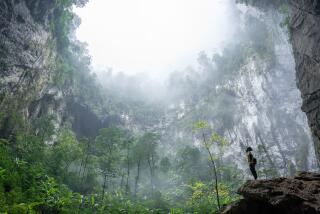SHOWS FOR YOUNGSTERS AND THEIR PARENTS TOO : Lessons in Antarctica, from the adventurous Sir David Attenborough
- Share via
Sir David Attenborough says he once considered himself “a chap who feels that the tropical rain forest is where I would enjoy myself.” But years of making documentaries in the warmer climates of the world made him realize that “the time has come to cover other places.”
He chose the other end of the spectrum, Antarctica. Surrounded by 90% of the world’s ice, temperatures can drop there as low as 90 degrees below zero-Farenheit. This week, Attenborough hosts Antarctica: Life in the Freezer.
Attenborough says: “When people ask me why I chose to go there, I say to them, ‘Why not?’ ”
Antarctica, Attenborough says, is “the last great unfilmed land. The plains of East Africa are very exciting, but we’ve seen a lot of them. Hardly anyone has seen undersea where penguins zoom around at 20 to 30 miles per hour, watch them hunted and captured by leopard seals.”
Some of the show’s other unusual sights include four-ton bull elephant seals fighting for control over a 100-female harem and miles of male empire penguins caring for their young.
Documenting all sides of the continent--which had never been done before--was a massive project, 2 1/2 years in the making.
The first step was research. “You go to extraordinary lengths,” he says. “It must be well planned and organized. There are so many things you need, including excellent communication devices, cameras, self-contained kits for each person with food, radios and medical packs.”
Some research had to be done on location. “This couldn’t have been done without detailed consultation with the British, American, New Zealand, Australian and Argentinian scientists,” the filmmaker says. “You need to have their cooperation, because you need to stay on their bases.” The international research scientists make up most of Antarctica’s 800-person population.
Six crews, using both film and video, worked in different areas of the continent, where almost everything is covered with ice all-year round.
Extraordinary underwater footage highlights the program, which is part of TBS’ “National Geographic Explorer” series. Divers, wearing special suits, were actually treated to warmer temperatures when they dipped into the icy seas. “If the waters were as cold as on land,” Attenborough says, “well, of course, they would be frozen.”
“You couldn’t even touch your naked finger to the camera without it sticking and damaging it,” Attenborough points out. “Even putting your eye to the eyepiece was a difficult problem.”
The temperatures proved treacherous for man as well as machine. Land and sea crews took great care with their equipment. Specially prepared cameras were used because conventional cameras contain oil and lubricants that freeze in subzero temperatures.
“Not only did they have to carry cameras everywhere, they were responsible for its repair,” he says, citing an example of a crew member who borrowed parts from his computer to repair a broken camera.
“Antarctica” aired in England as six half-hour segments. But Attenborough says that TBS’ decision to air the documentary as one three-hour show works well. “There is a narrative logic. Each of the original segments are chronologically documented from the beginning of spring, the warming of the continent right through the year, through winter, to the beginning of the next spring.”
Despite his initial reservations about braving the cold, Attenborough has no regrets. He hopes that his American audience “will find it as fascinating a place as I have. I hope they will watch the show and say, ‘It’s fascinating,’ because if you miss the grandeur of nature, you are missing the most rewarding experience of life.”
“Antarctica: Life in the Freezer” airs Monday at 5:05 p.m. and repeats at 8:05 p.m. and Saturday at 7:05 p.m. on TBS. For ages 6 and up.
More to Read
Sign up for The Wild
We’ll help you find the best places to hike, bike and run, as well as the perfect silent spots for meditation and yoga.
You may occasionally receive promotional content from the Los Angeles Times.





